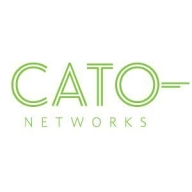


Check Point CloudGuard Network Security and Cato SASE Cloud Platform compete in the network security space. Cato SASE Cloud Platform appears to have the upper hand due to higher user satisfaction with its features.
Features: Check Point CloudGuard Network Security offers robust threat prevention, detailed security policies, and comprehensive network protection. Cato SASE Cloud Platform combines security with wide-area networking, providing an all-in-one solution, integrated security, and networking services seamlessly. Users find Cato's integrated approach and superior features more holistic.
Room for Improvement: Check Point CloudGuard Network Security needs better integration with third-party tools, simpler management options, and enhancements in user interface intuitiveness. Cato SASE Cloud Platform could improve its analytics, reporting features, and scalability. Users find Cato's straightforward management preferable.
Ease of Deployment and Customer Service: Check Point CloudGuard Network Security deployment is complex, requiring detailed setup and configuration. Customer service is effective but can be slow. Cato SASE Cloud Platform has a straightforward deployment process and responsive customer service. Users report Cato is easier to deploy and better supported.
Pricing and ROI: Check Point CloudGuard Network Security has a competitive initial setup cost but mixed ROI due to high ongoing expenses. Cato SASE Cloud Platform, while more expensive initially, offers better ROI due to its wide-ranging feature set and ease of use. Users are willing to invest more in Cato due to these factors.
Clients are now comfortable and not wasting productive hours on IT support.
We have experienced a positive return on investment by utilizing Fortinet's products.
There's definitely an ROI. Having a centralized way of managing and applying policies across the entire organization always helps.
The value lies in maintaining operational integrity with zero downtime or incidents, facilitating secure, ongoing business operations.
Implementing CloudGuard has resulted in an excellent return on investment over one hundred percent ROI.
The unified policy is comprehensive and helps me to create firewall policies that are shared across all our facilities and plants.
He explained that it required a command line configuration, as it couldn't be done through the graphical user interface.
I would rate their support for FortiGate a nine out of ten.
They offer very accurate solutions.
Our customer service experience is excellent
They usually respond quite fast, and they are very knowledgeable about what they do.
We had an endless loop of emails trying to fix this, and the suggestion was to reinstall the gateway and do it from scratch, which was not an option at that point because it would leave that specific location without access.
Available twenty-four by seven.
They scale up really well from smaller models like the FortiGate 40 and 50 to bigger sites with the FortiGate 100 for more throughput - up to enterprise datacenters.
The variation comes in terms of the interfaces and throughputs, but from a security perspective, you get the same benefit, irrespective of whether you have an entry-level unit or an enterprise.
There are many options available, and we can choose the size of the box based on our requirements.
I can deploy it everywhere I need it.
We have transitioned from 1,000 to 500 users without any issue.
We perform minor and major upgrades, and it works seamlessly.
There are no bugs or glitches, and it doesn't crash or freeze.
Improper handling of these can lead to a memory surge, a well-known bug that can cause the entire system to freeze.
It is less stable than Palo Alto Networks and Check Point firewalls because there are lots of bugs in the latest firmware.
I would rate the stability of the solution as ten on a scale of one to ten.
I have not observed any downtime.
For instance, when we are working on a release and do an upgrade, we start experiencing unexpected issues.
The solution is stable.
If I have put 10 GBPS of throughput on a firewall and I enable all of these features available, such as IPS or UTM functionalities, the throughput comes down to 1 GBPS.
By providing an integrated solution, users would have access to all features and functionalities within a single window, eliminating the need to navigate through multiple windows.
Investing in a solution that can accommodate such growth would be more cost-effective than repeatedly purchasing new hardware.
Scalability could be improved as well; needing to purchase a new license each time I want to add a new interface is not ideal.
Better documentation would be welcome.
The user interface could be more intuitive, and the initial setup and configuration can be complex, requiring a technical team.
Secure SD-WAN is free of charge.
The most expensive part is the renewal of the license subscription.
FortiGate is priced lower than Palo Alto.
The pricing is flexible due to our special partnership with Cato Networks.
The pricing and licensing are expensive, costing between seven thousand to eight thousand dollars.
Check Point is expensive, however, with the features and capabilities, I can justify the cost.
It is the highest in the market.
It's easy to monitor the end-to-end network through the firewall.
The firewall, IPS, and VPN functions are the most valuable features.
FortiGate provides solid protection against viruses, malware, and other threats.
One of the most valuable features is the automated threat prevention, which helps us detect and block potential cyberattacks in real-time, minimizing data breaches.
Centralized management is the feature I like best, resulting in reduced workload and more continuous policy.
Network Security provides us with unified security management across hybrid and cloud as well as on-prem.



Fortinet FortiGate offers comprehensive network security and firewall protection across multiple locations. It effectively manages data traffic and secures environments with features like VPN, intrusion prevention, and UTM controls.
Organizations rely on Fortinet FortiGate for its robust integration with advanced security policies, ensuring significant protection for enterprises, cloud environments, and educational sectors. It facilitates network segmentation, application-level security, and authentication management, securing communication within and between locations such as branches and data centers. Its efficient SD-WAN and UTM features enable streamlined data management and enhanced threat protection capabilities. Users appreciate its centralized management, facilitating seamless operations across diverse environments.
What are the key features of Fortinet FortiGate?
What benefits should users expect from Fortinet FortiGate?
Fortinet FortiGate is crucial in sectors like education, offering robust networks for secure data flow between campuses and facilitating remote learning. In enterprise environments, it allows efficient management of application traffic and security across multiple branches, while in the cloud, it seamlessly integrates with diverse platforms to enhance security infrastructure.
Cato Networks is a leading SASE (Secure Access Service Edge) platform, combining SD-WAN and network security to obtain a cloud-native service. Cato Networks optimizes and secures application access for users and identities. The platform delivers a next-generation secure networking architecture that minimizes legacy IT infrastructures’ complexity, costs, and risks. The goal of Cato Suite is to connect any user to any application securely and optimally.
Cato Suite runs on a private global network of more than 65 PoPs (points of presence) connected via SLA-backed network providers. The service can connect branches, data centers, users, and clouds. Cato can be deployed in stages to augment legacy network services.
Cato Suite delivers end-to-end route optimization for WAN and cloud traffic. The architecture is self-healing, enabling a high service uptime.
Cato Features
Cato Cloud has a global backbone to deliver a reliable, global network. Here are some key SD-WAN features of Cato Cloud.
What challenges does Cato Network solve?
MPLS (multi-protocol label switching) networks are usually expensive and limited in their capacity. Cato simplifies migrating to a faster, higher-capacity internet and SASE cloud. Cato SD-WAN appliances enable customers to improve usable capacity and resiliency.
Customers who suffer from the challenge of high latency and network inconsistency can use Cato to deliver a consistent connection and user experience to access on-premises and cloud applications.
Cato’s complete network security stack connects all branch locations to the Cato cloud, therefore protecting all traffic, both internet-bound and WAN, with enterprise-grade, cloud-based security services. This capability avoids having to backhaul internet traffic to a data center or hub or having to implement stand-alone cloud security solutions.
Organizations using Cato notice an acceleration of cloud traffic. Cato achieves this by routing all traffic from the edges to the PoP closest to the data center. Because of the close distance between the two, the latency is near zero.
Reviews from Real Users
An IT manager/project coordinator at a healthcare company says that “[Cato is] a cloud-based solution that integrates well with everything. They are the classic SaaS solution.”
Yeong-Gi L., a network engineer at Snetsystems, notes that “The solution is very stable. The scalability is quite good. Technical support was always helpful and responsive. The integration capabilities are not a problem at all.”
"The most valuable feature is that it also works as a next-gen firewall because it has security features," says Lorenzo S., senior solutions consultant Lead at MDI.
Check Point CloudGuard Network Security is designed to secure cloud assets, offering robust firewall capabilities and protection for both internal and external traffic across AWS, Azure, and on-premises environments.
Enterprises rely on Check Point CloudGuard Network Security for comprehensive network protection, threat prevention, and compliance enforcement. Supporting virtual machines and hybrid environments, it delivers advanced security measures including intrusion prevention and application control. Key functions include firewall security, network segmentation, and cloud environment protection, ensuring businesses maintain a secure and compliant IT infrastructure.
What are the most valuable features of Check Point CloudGuard Network Security?In industries such as financial services, healthcare, retail, and education, Check Point CloudGuard Network Security is implemented to safeguard sensitive data, ensure compliance, and protect critical infrastructure. Companies in these sectors benefit from its advanced threat prevention and flexible deployment options, meeting their stringent security requirements while enabling secure digital transformation.
We monitor all Software Defined WAN (SD-WAN) Solutions reviews to prevent fraudulent reviews and keep review quality high. We do not post reviews by company employees or direct competitors. We validate each review for authenticity via cross-reference with LinkedIn, and personal follow-up with the reviewer when necessary.